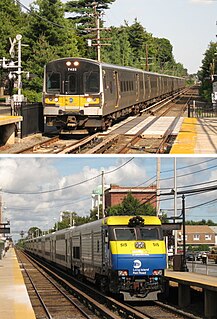
The Long Island Rail Road, often abbreviated as the LIRR, is a commuter rail system in the southeastern part of the U.S. state of New York, stretching from Manhattan to the eastern tip of Suffolk County on Long Island. With an average weekday ridership of 354,800 passengers in 2016, it is the busiest commuter railroad in North America. It is also one of the world's few commuter systems that runs 24/7 year-round. It is publicly owned by the Metropolitan Transportation Authority, which refers to it as MTA Long Island Rail Road.
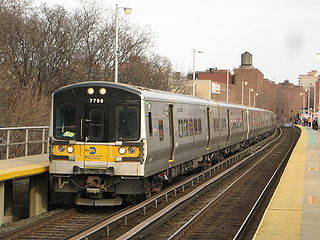
The Port Washington Branch is an electrified two-track rail line and service owned and operated by the Long Island Rail Road in the U.S. state of New York. It branches north from the Main Line at the former Winfield Junction station, just east of the Woodside station in the New York City borough of Queens, and runs roughly parallel to Northern Boulevard past Mets-Willets Point, Flushing, Murray Hill, Broadway, Auburndale, Bayside, Douglaston, Little Neck, and then crosses into Nassau County for stops in Great Neck, Manhasset, and Plandome before terminating at Port Washington.
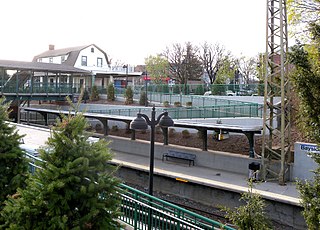
Bayside is a station on the Long Island Rail Road's Port Washington Branch in the Bayside neighborhood of Queens, New York City. The station is located at 213th Street and 41st Avenue, off Bell Boulevard and just north of Northern Boulevard, and is 12.6 miles (20.3 km) from Penn Station in Midtown Manhattan. The station is part of CityTicket.

Little Neck is a station on the Long Island Rail Road's Port Washington Branch in the Little Neck neighborhood of Queens, New York City. The station is at Little Neck Parkway and 39th Road, about half a mile north of Northern Boulevard. Little Neck station is 14.5 miles (23.3 km) from Penn Station in Midtown Manhattan, and is the easternmost station on the Port Washington Branch in New York City. The station house is located on the south (eastbound) side, unlike most station houses on the Port Washington Branch. The station is part of the CityTicket program and is in Zone 3.

Far Rockaway is the terminus of the Long Island Rail Road's Far Rockaway Branch in the Far Rockaway neighborhood of Queens in New York City. The station is located at Nameoke Street and Redfern Avenue, and is 23.0 miles (37 km) from Penn Station in Midtown Manhattan, and mean travel time is 56 minutes, although most off-peak trains terminate at Atlantic Terminal, thus requiring a transfer for service to Penn Station.

The Hempstead Branch is an electrified rail line and service owned and operated by the Long Island Rail Road in the U.S. state of New York. The branch begins at the Main Line at Queens Interlocking, just east of Queens Village station. It parallels the Main Line past Bellerose to Floral Park, where it splits southward and continues east via the village of Garden City to Hempstead Crossing. There it turns south to the final two stations, Country Life Press and Hempstead.

Merillon Avenue is a station on the Long Island Rail Road's Main Line. It is located at Nassau Boulevard and Merillon Avenue in Garden City Park, New York. The station is wheelchair accessible with two side platforms and a cross-under at Nassau Boulevard.
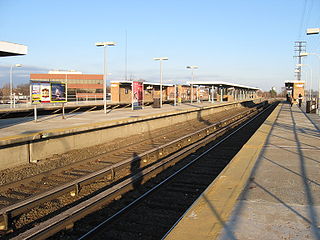
Floral Park is a Long Island Rail Road train station in Floral Park, New York, at Tulip and Atlantic Avenues, on the Main Line and Hempstead Branch just west of their split. Most trains serving this station run to or from Hempstead, but limited Main Line trains stop here on weekday mornings. The station is ADA accessible as of July 16, 2021.

The Central Branch is a rail line owned and operated by the Long Island Rail Road (LIRR) in the U.S. state of New York, extending from 40.734°N 73.470°W just east of Bethpage station to 40.696°N 73.341°W just west of Babylon station. It was built in 1873 as part of the Babylon Extension of the Central Railroad of Long Island (CRRLI), which was owned by Alexander Turney Stewart. The branch was mostly unused following the 1876 merger of the CRRLI and the LIRR, but in 1925 it was rebuilt and reconfigured to connect Bethpage and Babylon stations.
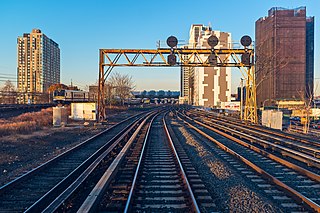
The Main Line is a rail line owned and operated by the Long Island Rail Road in the U.S. state of New York. It begins as a two-track line at the Long Island City station in Long Island City, Queens, and runs along the middle of Long Island about 95 miles (153 km) to the Greenport station in Greenport, Suffolk County. A mile east of the Long Island City station, the four tracks of the East River Tunnels join the two tracks from Long Island City; most Main Line trains use these tunnels rather than running to or from Long Island City.

The Whitestone Branch was a branch of the Long Island Rail Road, running north and east along the left bank of the Flushing River from the Port Washington Branch near the modern Willets Point/Flushing sections of Queens, New York. It crossed the river on one of the three bridges that were later torn down for the Van Wyck Expressway, then ran north along Flushing Bay and east along the East River to Whitestone.
The Long Island Rail Road is a railroad owned by the Metropolitan Transportation Authority in the U.S. state of New York. It is the oldest United States railroad still operating under its original name and charter. It consolidated several other companies in the late 19th century. The Pennsylvania Railroad owned the Long Island Rail Road for the majority of the 20th century and sold it to the State in 1966.
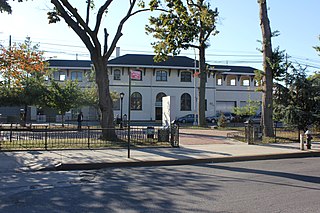
Queens Village is a station on the Long Island Rail Road's Main Line, located between 218th Street and Springfield Boulevard, in the Queens Village neighborhood of Queens, New York City. It has two side platforms along the four-track line, and, except for one AM peak westbound train from East Williston on the Oyster Bay Branch, is served by Hempstead Branch trains only. Just east of the station is Queens Interlocking, a universal interlocking that splits the four-track line into two parallel two-track lines—the Main Line and Hempstead Branch—and controls the junction with the spur to Belmont Park. The station is elevated and the tracks leading in and out are on raised ground and only above the road at intersections.

Deer Park is a station along the Main Line of the Long Island Rail Road. It is officially located at Pineaire Drive, Executive Avenue, and Long Island Avenue near Deer Park, New York. The actual location is in Baywood, New York, directly over the Deer Park border.

The Bethpage Branch was a branch of the Long Island Rail Road (LIRR), running from the present-day split between the Ronkonkoma Branch and Central Branch north about 1+3⁄4 miles (2.8 km) to present-day Old Bethpage, New York.
The Garden City–Mitchell Field Secondary is a lightly used freight branch of the Long Island Rail Road. It is a spur off the Hempstead Branch.

The Bushwick Branch, also called the Bushwick Lead Track, is a freight railroad branch in New York City. It runs from Bushwick in Brooklyn to Fresh Pond Junction in Glendale, Queens, where it connects with the Montauk Branch of the Long Island Rail Road. It is owned by the LIRR but operated under lease by the New York and Atlantic Railway, which took over LIRR freight operations in May 1997.
Central Railroad of Long Island was built on Long Island, New York, by Alexander Turney Stewart, who was also the founder of Garden City. The railroad was established in 1871, then merged with the Flushing and North Side Railroad in 1874 to form the Flushing, North Shore and Central Railroad. It was finally acquired by the Long Island Rail Road in 1876 and divided into separate branches. Despite its short existence, the CRRLI had a major impact on railroading and development on Long Island.
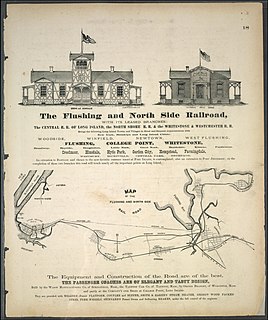
The Flushing and North Side Railroad was a former railroad on Long Island built by Conrad Poppenhusen as a replacement for the former New York and Flushing Railroad. The railroad was established in 1868, was merged with the Central Railroad of Long Island in 1874 to form the Flushing, North Shore and Central Railroad, and was finally acquired by the Long Island Rail Road in 1876. Today the main line is known as the Port Washington Branch of the Long Island Rail Road.
The White Line was a short-lived branch of the Long Island Rail Road in western Queens County, New York. Officially known as the Newtown and Flushing Railroad, the line was chartered in 1871, but was only in service from 1873 to 1876.

















